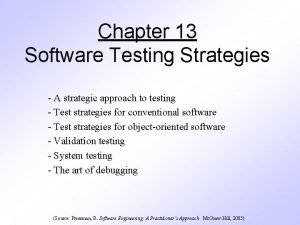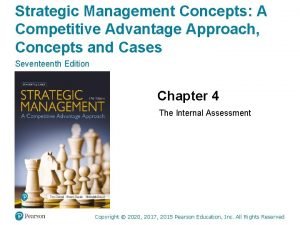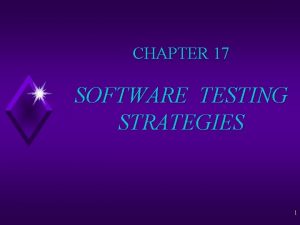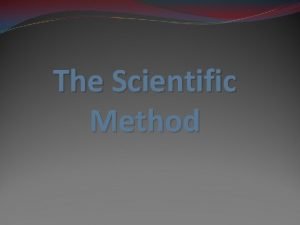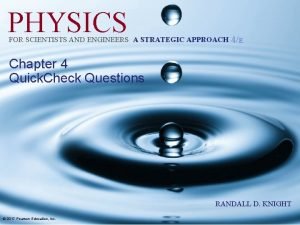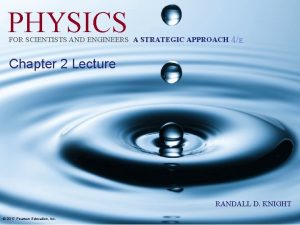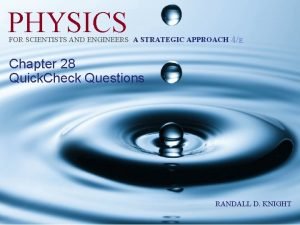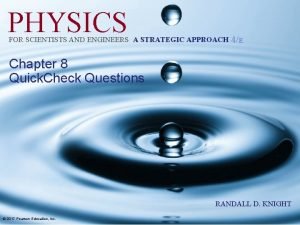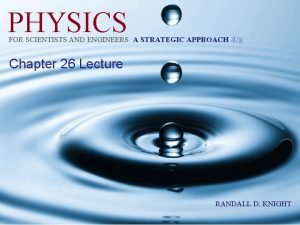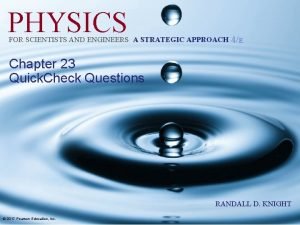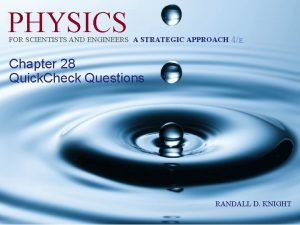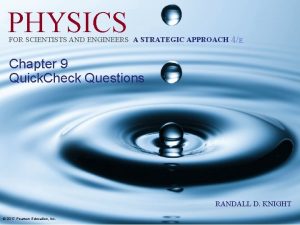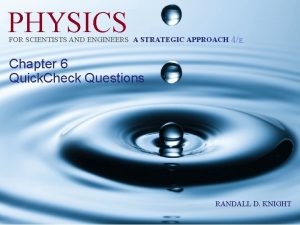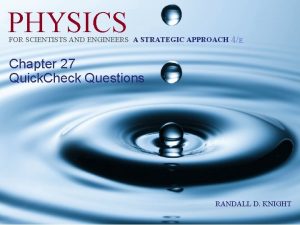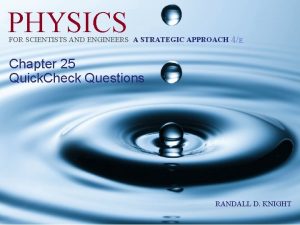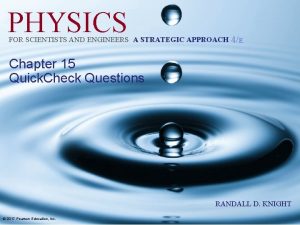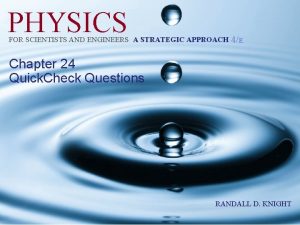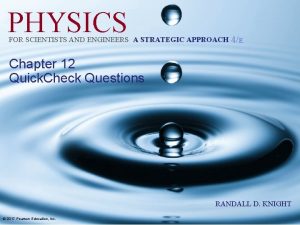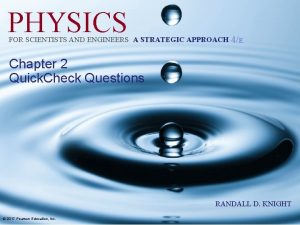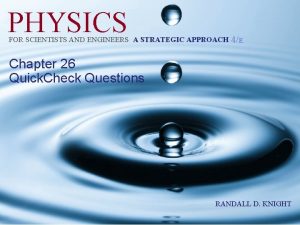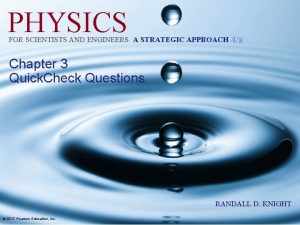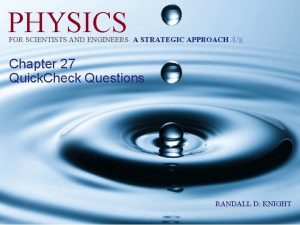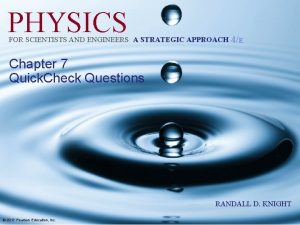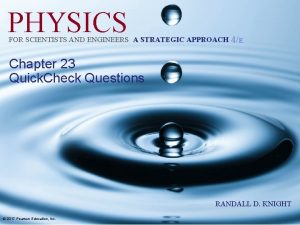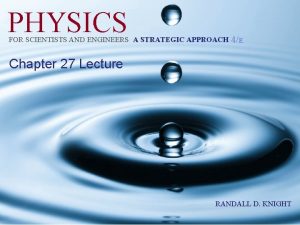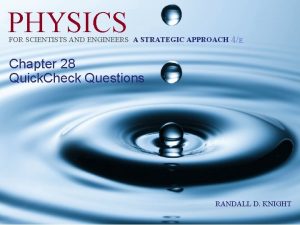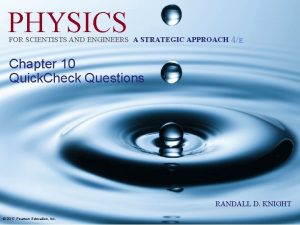PHYSICS FOR SCIENTISTS AND ENGINEERS A STRATEGIC APPROACH




























- Slides: 28

PHYSICS FOR SCIENTISTS AND ENGINEERS A STRATEGIC APPROACH 4/E Chapter 5 Quick. Check Questions RANDALL D. KNIGHT © 2017 Pearson Education, Inc.

Quick. Check 5. 1 A ball rolls down an incline and off a horizontal ramp. Ignoring air resistance, what force or forces act on the ball as it moves through the air just after leaving the horizontal ramp? A. The weight of the ball acting vertically down. B. A horizontal force that maintains the motion. C. A force whose direction changes as the direction of motion changes. D. The weight of the ball and a horizontal force. E. The weight of the ball and a force in the direction of motion. © 2017 Pearson Education, Inc. Slide 5 -2

Quick. Check 5. 1 A ball rolls down an incline and off a horizontal ramp. Ignoring air resistance, what force or forces act on the ball as it moves through the air just after leaving the horizontal ramp? A. The weight of the ball acting vertically down. B. A horizontal force that maintains the motion. C. A force whose direction changes as the direction of motion changes. D. The weight of the ball and a horizontal force. E. The weight of the ball and a force in the direction of motion. The answer will be deferred until later. © 2017 Pearson Education, Inc. Slide 5 -3

Quick. Check 5. 2 The net force on an object points to the left. Two of three forces are shown. Which is the missing third force? A. © 2017 Pearson Education, Inc. B. C. D. Slide 5 -4

Quick. Check 5. 2 The net force on an object points to the left. Two of three forces are shown. Which is the missing third force? A. © 2017 Pearson Education, Inc. B. C. Vertical components cancel D. Slide 5 -5

Quick. Check 5. 3 A steel beam hangs from a cable as a crane lifts the beam. What forces act on the beam? A. Gravity. B. Gravity and tension in the cable. C. Gravity and a force of motion. D. Gravity and tension and a force of motion. © 2017 Pearson Education, Inc. Slide 5 -6

Quick. Check 5. 3 A steel beam hangs from a cable as a crane lifts the beam. What forces act on the beam? A. Gravity. B. Gravity and tension in the cable. C. Gravity and a force of motion. D. Gravity and tension and a force of motion. © 2017 Pearson Education, Inc. Slide 5 -7

Quick. Check 5. 4 A book rests on a horizontal table. Gravity pulls down on the book. You may have learned something in a previous physics class about an upward force called the “normal force. ” Deep in your heart, do you really believe the table is exerting an upward force on the book? A. Yes, I’m quite confident the table exerts an upward force on the book. B. No, I don’t see how the table can exert such a force. C. I really don’t know. © 2017 Pearson Education, Inc. Slide 5 -8

Quick. Check 5. 5 A bobsledder pushes her sled across horizontal snow to get it going, then jumps in. After she jumps in, the sled gradually slows to a halt. What forces act on the sled just after she’s jumped in? A. Gravity and kinetic friction. B. Gravity and a normal force. C. Gravity and the force of the push. D. Gravity, a normal force, and kinetic friction. E. Gravity, a normal force, kinetic friction, and the force of the push. © 2017 Pearson Education, Inc. Slide 5 -9

Quick. Check 5. 5 A bobsledder pushes her sled across horizontal snow to get it going, then jumps in. After she jumps in, the sled gradually slows to a halt. What forces act on the sled just after she’s jumped in? A. Gravity and kinetic friction. B. Gravity and a normal force. C. Gravity and the force of the push. D. Gravity, a normal force, and kinetic friction. E. Gravity, a normal force, kinetic friction, and the force of the push. © 2017 Pearson Education, Inc. Slide 5 -10

Quick. Check 5. 1 (revisited) A ball rolls down an incline and off a horizontal ramp. Ignoring air resistance, what force or forces act on the ball as it moves through the air just after leaving the horizontal ramp? A. The weight of the ball acting vertically down. B. A horizontal force that maintains the motion. C. A force whose direction changes as the direction of motion changes. D. The weight of the ball and a horizontal force. E. The weight of the ball and a force in the direction of motion. © 2017 Pearson Education, Inc. Slide 5 -11

Quick. Check 5. 1 (revisited) A ball rolls down an incline and off a horizontal ramp. Ignoring air resistance, what force or forces act on the ball as it moves through the air just after leaving the horizontal ramp? A. The weight of the ball acting vertically down. B. A horizontal force that maintains the motion. C. A force whose direction changes as the direction of motion changes. D. The weight of the ball and a horizontal force. E. The weight of the ball and a force in the direction of motion. © 2017 Pearson Education, Inc. Slide 5 -12

Quick. Check 5. 6 A cart is pulled to the right with a constant, steady force. How will its acceleration graph look? A. © 2017 Pearson Education, Inc. B. C. Slide 5 -13

Quick. Check 5. 6 A cart is pulled to the right with a constant, steady force. How will its acceleration graph look? A. B. C. A constant force produces a constant acceleration. © 2017 Pearson Education, Inc. Slide 5 -14

Quick. Check 5. 7 A constant force causes an object to accelerate at 4 m/s 2. What is the acceleration of an object with twice the mass that experiences the same force? A. 1 m/s 2 B. 2 m/s 2 C. 4 m/s 2 D. 8 m/s 2 E. 16 m/s 2 © 2017 Pearson Education, Inc. Slide 5 -15

Quick. Check 5. 7 A constant force causes an object to accelerate at 4 m/s 2. What is the acceleration of an object with twice the mass that experiences the same force? A. 1 m/s 2 B. 2 m/s 2 C. 4 m/s 2 D. 8 m/s 2 E. 16 m/s 2 © 2017 Pearson Education, Inc. Slide 5 -16

Quick. Check 5. 8 An object on a rope is lowered at constant speed. Which is true? A. The rope tension is greater than the object’s weight. B. The rope tension equals the object’s weight. C. The rope tension is less than the object’s weight. D. The rope tension can’t be compared to the object’s weight. © 2017 Pearson Education, Inc. Slide 5 -17

Quick. Check 5. 8 An object on a rope is lowered at constant speed. Which is true? Constant velocity Zero acceleration A. The rope tension is greater than the object’s weight. B. The rope tension equals the object’s weight. C. The rope tension is less than the object’s weight. D. The rope tension can’t be compared to the object’s weight. © 2017 Pearson Education, Inc. Slide 5 -18

Quick. Check 5. 9 An object on a rope is lowered at a steadily decreasing speed. Which is true? A. The rope tension is greater than the object’s weight. B. The rope tension equals the object’s weight. C. The rope tension is less than the object’s weight. D. The rope tension can’t be compared to the object’s weight. © 2017 Pearson Education, Inc. Slide 5 -19

Quick. Check 5. 9 An object on a rope is lowered at a steadily decreasing speed. Which is true? Decreasing downward velocity Acceleration vector points up A. The rope tension is greater than the object’s weight. B. The rope tension equals the object’s weight. C. The rope tension is less than the object’s weight. D. The rope tension can’t be compared to the object’s weight. © 2017 Pearson Education, Inc. Slide 5 -20

Quick. Check 5. 10 A hollow tube lies flat on a table. A ball is shot through the tube. As the ball emerges from the other end, which path does it follow? © 2017 Pearson Education, Inc. Slide 5 -21

Quick. Check 5. 10 A hollow tube lies flat on a table. A ball is shot through the tube. As the ball emerges from the other end, which path does it follow? © 2017 Pearson Education, Inc. C Slide 5 -22

Quick. Check 5. 11 An elevator, lifted by a cable, is moving upward and slowing. Which is the correct free-body diagram? A. © 2017 Pearson Education, Inc. B. C. D. E. Slide 5 -23

Quick. Check 5. 11 An elevator, lifted by a cable, is moving upward and slowing. Which is the correct free-body diagram? A. © 2017 Pearson Education, Inc. B. C. D. E. Slide 5 -24

Quick. Check 5. 12 A ball has been tossed straight up. Which is the correct free-body diagram just after the ball has left the hand? Ignore air resistance. A. © 2017 Pearson Education, Inc. B. C. D. Slide 5 -25

Quick. Check 5. 12 A ball has been tossed straight up. Which is the correct free-body diagram just after the ball has left the hand? Ignore air resistance. A. © 2017 Pearson Education, Inc. B. C. D. No points of contact. Gravity is the only force. Slide 5 -26

Quick. Check 5. 13 A ball, hanging from the ceiling by a string, is pulled back and released. Which is the correct free-body diagram just after its release? A. © 2017 Pearson Education, Inc. B. C. D. E. Slide 5 -27

Quick. Check 5. 13 A ball, hanging from the ceiling by a string, is pulled back and released. Which is the correct free-body diagram just after its release? A. © 2017 Pearson Education, Inc. B. C. D. E. Slide 5 -28
 Strategic substitutes and strategic complements
Strategic substitutes and strategic complements Industrial organization model of above average returns
Industrial organization model of above average returns Strategy analysis and choice largely involves making
Strategy analysis and choice largely involves making Difference between datagram and virtual circuit switching
Difference between datagram and virtual circuit switching Tony wagner's seven survival skills
Tony wagner's seven survival skills Strategic fit vs strategic intent
Strategic fit vs strategic intent Incremental approach in strategic management
Incremental approach in strategic management Strategic control and corporate governance
Strategic control and corporate governance Strategic choice approach
Strategic choice approach A strategic approach to software testing
A strategic approach to software testing Strategic management a competitive advantage approach
Strategic management a competitive advantage approach A strategic approach to software testing
A strategic approach to software testing Crescive approach
Crescive approach After the experiment scientists organize and the data
After the experiment scientists organize and the data Diagrams tables and graphs are used by scientists mainly to
Diagrams tables and graphs are used by scientists mainly to Why does it happen
Why does it happen University physics with modern physics fifteenth edition
University physics with modern physics fifteenth edition How to write a physics ia
How to write a physics ia Formuö
Formuö Typiska novell drag
Typiska novell drag Tack för att ni lyssnade bild
Tack för att ni lyssnade bild Vad står k.r.å.k.a.n för
Vad står k.r.å.k.a.n för Varför kallas perioden 1918-1939 för mellankrigstiden
Varför kallas perioden 1918-1939 för mellankrigstiden En lathund för arbete med kontinuitetshantering
En lathund för arbete med kontinuitetshantering Personalliggare bygg undantag
Personalliggare bygg undantag Vilotidsbok
Vilotidsbok Anatomi organ reproduksi
Anatomi organ reproduksi Förklara densitet för barn
Förklara densitet för barn Datorkunskap för nybörjare
Datorkunskap för nybörjare









